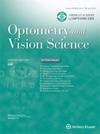有症状和无症状软性隐形眼镜佩戴者的眼部热成像和临床测量。
IF 1.8
4区 医学
Q3 OPHTHALMOLOGY
引用次数: 0
摘要
意义干涩和不适症状是隐形眼镜脱落的主要原因。为此目的进行的临床测试都是侵入性或主观性的。本研究旨在调查有症状和无症状的习惯性软性隐形眼镜配戴者的眼部热成像与临床测量之间的关系。方法将 40 名习惯性隐形眼镜配戴者分为年龄和性别匹配的无症状组和有症状组(隐形眼镜不适感问卷评分分别为≤8 分和≥14 分)。临床测量在第 1 次检查(戴隐形眼镜时和摘除隐形眼镜后)和 2 周冲洗期后的基线(第 2 次检查)进行。对眼表疾病指数(OSDI)问卷、无创泪液破裂时间、球结膜充血和角膜染色进行了评估。计算自然眨眼(30 秒)和持续睁眼(10 秒)时角膜中央和下部的散热率。结果有症状组在佩戴隐形眼镜期间(p<0.001)和基线时(p = 0.001)的干眼症状(OSDI 评分)明显高于无症状组(p = 0.001)。有症状组在佩戴隐形眼镜时下部角膜(10 秒,p=0.013)和摘下隐形眼镜后中央角膜(30 秒,p=0.045)的热降温率明显更高。在基线时,干眼症状(OSDI 评分)与症状组角膜中央区域的冷却率显著相关(30 秒:r = -0.5,p=0.03;10 秒:r = -0.63,p=0.005)。无创泪液破裂时间与症状组角膜中央区域基线冷却率相关(30 秒:r = 0.6,p=0.005;10 秒:r = 0.55,p=0.018)。角膜中央区域的冷却率(10 秒持续时间,p<0.0001)和无创泪液破裂时间(p<0.0001)被确定为基线干眼症状的显著预测变量。这些发现可能表明,在隐形眼镜不适的评估中,眼部热成像技术还有进一步应用的潜力。本文章由计算机程序翻译,如有差异,请以英文原文为准。
Ocular thermography and clinical measurements in symptomatic and asymptomatic soft contact lens wearers.
SIGNIFICANCE
Symptoms of dryness and discomfort are the main reasons for contact lens dropout. Clinical tests for this purpose are invasive or subjective. Ocular thermography may help to assess the ocular discomfort and dryness in noninvasive and objective manner.
PURPOSE
This study aimed to investigate the relationship of ocular thermography with clinical measurements in habitual symptomatic and asymptomatic soft contact lens wearers.
METHODS
Forty habitual contact lens wearers were evaluated in two age- and gender-matched asymptomatic and symptomatic groups (Contact Lens Discomfort Questionnaire scores ≤8 and ≥14, respectively). Clinical measurements took place during visit 1 (with contact lens in situ and after contact lens removal) and at baseline after a 2-week washout period (visit 2). The Ocular Surface Disease Index (OSDI) questionnaire, noninvasive tear breakup time, bulbar conjunctival hyperemia, and corneal staining were assessed. Thermal cooling rate was computed in the central and lower cornea during natural blinking (30 s) and sustained eye opening (10 s).
RESULTS
Dry eye symptoms (OSDI score) were significantly higher in the symptomatic group during contact lens wear (p<0.001) and at baseline (p = 0.001). Thermal cooling rate was significantly higher in the symptomatic group in the lower cornea (10 s, p=0.013) with the contact lens in situ and in the central cornea (30 s, p=0.045) after contact lens removal. At baseline, dry eye symptoms (OSDI score) significantly correlated with cooling rate in the central cornea region for the symptomatic group (30 s: r = -0.5, p=0.03; 10 s: r = -0.63, p=0.005). Noninvasive tear breakup time correlated with cooling rate in the central cornea region at baseline in the symptomatic group (30 s, r = 0.6, p=0.005; 10 s, r = 0.55, p=0.018). Cooling rate in the central cornea region (10-s duration, p<0.0001) and noninvasive tear breakup time (p<0.0001) were identified as significant predictor variables for dry eye symptoms at baseline.
CONCLUSIONS
Noninvasive tear breakup time and thermal cooling rate were identified as significant predictor variables for contact lens-induced dry eye. These findings may suggest the potential for the additional application of ocular thermography in the evaluation of contact lens discomfort.
求助全文
通过发布文献求助,成功后即可免费获取论文全文。
去求助
来源期刊

Optometry and Vision Science
医学-眼科学
CiteScore
2.80
自引率
7.10%
发文量
210
审稿时长
3-6 weeks
期刊介绍:
Optometry and Vision Science is the monthly peer-reviewed scientific publication of the American Academy of Optometry, publishing original research since 1924. Optometry and Vision Science is an internationally recognized source for education and information on current discoveries in optometry, physiological optics, vision science, and related fields. The journal considers original contributions that advance clinical practice, vision science, and public health. Authors should remember that the journal reaches readers worldwide and their submissions should be relevant and of interest to a broad audience. Topical priorities include, but are not limited to: clinical and laboratory research, evidence-based reviews, contact lenses, ocular growth and refractive error development, eye movements, visual function and perception, biology of the eye and ocular disease, epidemiology and public health, biomedical optics and instrumentation, novel and important clinical observations and treatments, and optometric education.
 求助内容:
求助内容: 应助结果提醒方式:
应助结果提醒方式:


